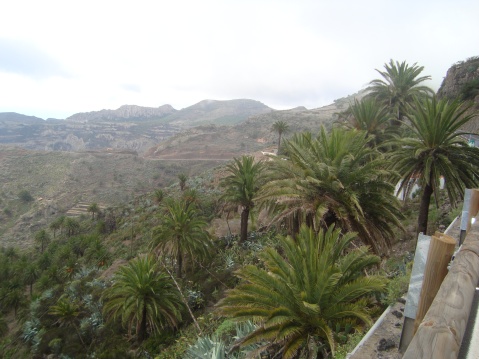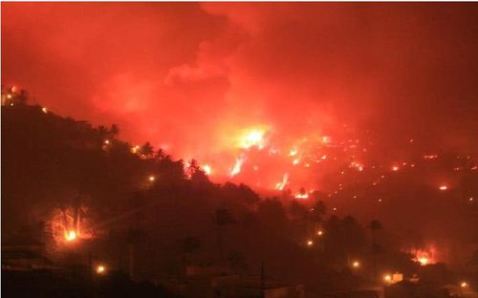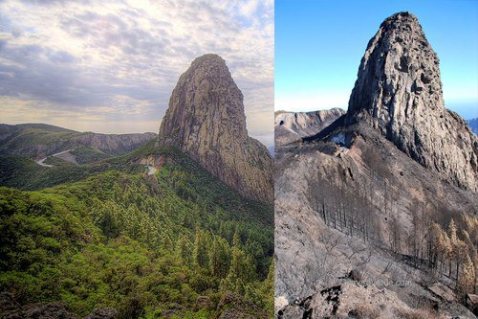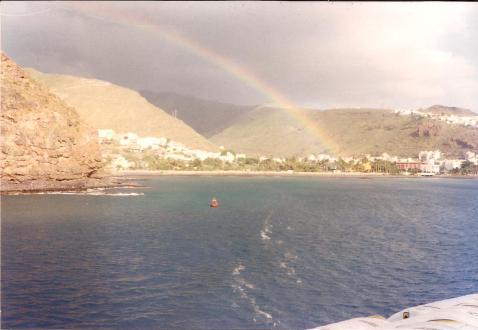The Tears of La Gomera
“Wildfire has destroyed part of Garajonay rainforest, a biosphere reserve of incalculable ecological value.”
In August, 2012, wildfires engulfed part of La Gomera, one of the Spanish Canary Islands. At the time of writing this, four weeks after the first fires started, fire-fighters have managed to bring the blaze under control, although it is still not extinguished entirely. Due to the intense heat wave currently affecting many parts of Spain and North Africa and the prolonged spell of drought, there are still fears that the flames may revive.
“According to some reports, almost 12 percent of the island’s total surface area, over 4,000 hectares of land have been devastated by the forest fires.”
Recent FIRES which devastated part of the island of La Gomera are believed to have been started by arsonists as three separate points of origin were reported around 14.45 on August 4, 2012, according to the local authorities.“More than 5,000 people were evacuated as the flames spread towards their homes during the worst part of the ordeal.”
A fourth of the island’s population were evacuated, 900 of these by ferry to neighbouring Tenerife, as the fires raged out of control towards the towns of Vallehermoso and Valle Gran Rey.
La Gomera’s emergency services and local volunteers were backed up by fire-fighters, helicopters and cistern planes from other Canary Islands in the battle to extinguish the inferno. The wildfire was so serious that Spanish military reinforcements were brought in and at one point the Moroccan government also offered it’s help.
Almost 100 homes were damaged by the blaze in Valle Gran Rey alone and many of these are to be demolished. Apart from damage to property, agriculture and livestock, the unique terraced countryside has been affected.
Officials estimate that the fires have affected some 3,000 hectares of land in La Gomera, 8 per cent of the territory, although other sources put this figure as high as 12 per cent.
“Garajonay National Park, a Unesco World Heritage Site was badly affected by the fire.”
Initial reports suggest that 750 hectares were burnt in the Garajonay National Park, roughly 25 per cent of the total area of protected rainforest. It may take three decades for the sub-tropical forest to recover from this disaster.While a political battle is rife in the area, with local and regional politicians trying to lay the blame with each other, islanders believe that delays and hindrance in extinguishing the blaze were partly due to restrictions to the fire-fighting services, a direct result of the current Spanish government’s fierce policy to curb public spending in response to the economical recession that the country is suffering.
Meanwhile, the islanders are rallying together and are supporting local platforms (such as LaGomeraSeMueve o plataformavallegranrey.com) to clarify the events, to support and claim compensation for those whose livelihood has been affected, to restore damaged infrastructure and to demand improved fire-fighting measures for the future.
World Wildlife Fund, Greenpeace and other environmental organisations have repeatedly warned Spain over inadequate forest fire prevention programmes.
At the time of writing this, the wildfire is under control but a focal point of fire is still active underground at the top of Los Gallos ravine and will remain smouldering for several weeks to come before, hopefully, being extinguished eventually by when it rains this Autumn.
Those involved agree that this disaster should have little impact on the island’s tourism.
“La Gomera is wounded, but it is a magical island that hasn’t lost its enchantment, it is still beautiful and most importantly the islanders determination and love of their homeland will keep it this way.”
In Spain, so far this year over 330,000 acres have burned and ten people have been killed including two fire-fighters in Torremanzanas, province of Alicante.
ƸӜƷ.•°*”˜* LA GOMERA – THE MAGICAL ISLAND *˜”*°•.ƸӜƷ
Not primarily an island for sun seekers, steep-sided and mountainous, the enchantment of the ‘Magic Island’ is special and different. La Gomera, 372 square km in size, lies to the west of Tenerife, and is one of seven Spanish islands that make up the Canary Archipelago off the north-west coast of Africa, in the Atlantic Ocean.
While holidaying in Tenerife we decided to take a day trip over to discover this mysterious island, which seems to be forever shrouded in mist. Setting off early, the ferry left Los Cristianos harbour and sitting on deck, sailing past the towering cliffs of Los Gigantes, the views were marvellous.
Arriving in San Sebastián de la Gomera, the island’s main port, is quite amazing as the island seems to rise out of the sea dwarfing the charming town with its steep sloping escarpments. Being colonised by the Spanish in the 16th century this was once an important intermediate port between Europe and the Americas and it still maintains a colonial feel.
La Gomera is the only island in the Canaries that hasn’t experienced a volcanic eruption in recent times (approximately two million years ago) and the lava fields have been eroded away leaving a series of deep ravines.
Our coach climbed up the twisting road to the Garajonay National Park, which encompasses the central plateau of the island, 70 per cent of which is a laurisilva rain forest. The lushness of the prehistoric vegetation is maintained by a fine mist, the result of unique climatic conditions. With a constant temperature of between 13 and 15 degrees centigrade all year round, it is a refreshing change from the sun of neighbouring Tenerife.
The bus stopped so we could enjoy a stroll along the paths, this place seems made for walkers and hikers with a network of routes, peaceful and indescribably beautiful, as the Earth once was millions of years ago.
There are rope bridges to cross the deep ravines if you are touring the island on foot but we had to get back to our coach and unfortunately couldn’t adventure further. The guide was very good, speaking at least 12 languages or so it seemed, she explained the legend of Gara and Jonay, lovers who committed suicide here, hence the name Garajonay.

Photo by Rosa Mª Alonso – courtesy of http://tourismcommunity.blogspot.com
La Gomera is almost round in shape, with the valleys covered in palms, ferns and heather. A special ‘whistle’ language has been used during centuries by the inhabitants to communicate across the valleys. Valle Gran Rey and Playa de Santiago are the closest thing you will get to a tourist resort on the island, the former sits on an almost impossibly photogenic valley of small white houses, bright green terraced fields and is frequented by surfers.
Stopping in a tiny hamlet for refreshments, we tried the local cheese (made from the milk of three species of prehistoric got breeds) considered by some to be the best in the world. I loved the ‘almogrote’, made from the cheese, pure olive oil, garlic and peppers, it makes a tasty, spicy spread ideal for the crusty bread, which went well with a glass of the local wine. Palm tree honey is another delicacy, used in desserts and cakes or served with cheese or ‘gofio’, a toasted wheat or corn flour.
On our way again, the coach took us through the Vallehermoso passing ‘Roque Cano’ an impressive monolith with vertical walls 250m high. Caused by volcanic activity there are several ‘roques’ scattered over the island.
Vines were brought over from the Americas and have been cultivated in this valley since the 14th century, when they became very popular among the European Courts.
Continuing through dense forest on the way back down to San Sebastian, the driver showed us his skilled on the treacherous mountain roads. With an hour to spare before catching the ferry there was time to wander around this charming Colombian town.
Sailing into the sunset, heading towards Tenerife and her ever visible El Teide volcano peeking above the clouds, after enjoying a lovely day we promised ourselves the pleasure of coming back sometime in the near future for a longer stay to further explore and relax in the unspoilt beauty of this lovely island…




